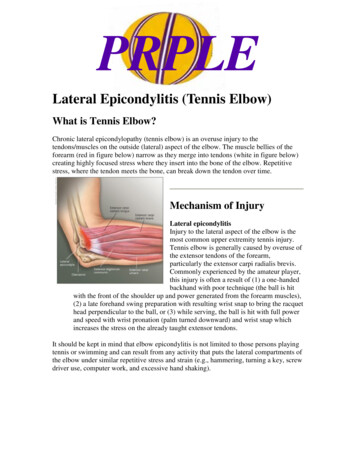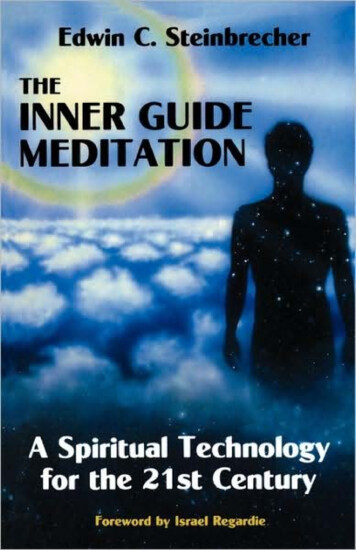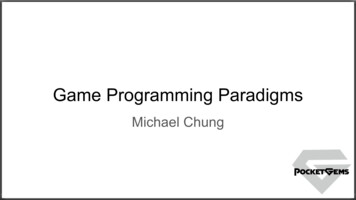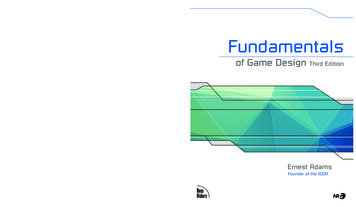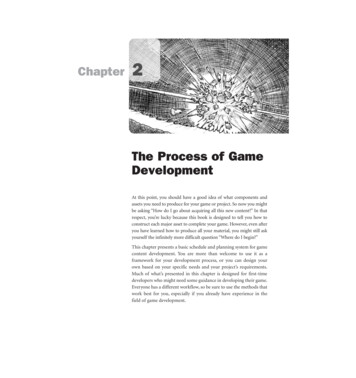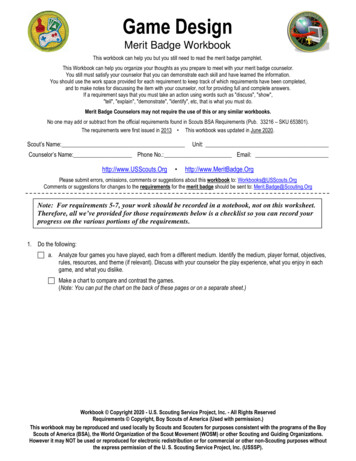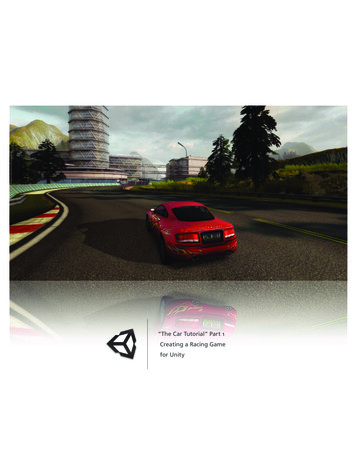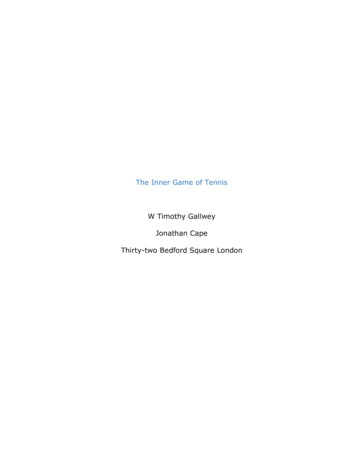
Transcription
The Inner Game of TennisW Timothy GallweyJonathan CapeThirty-two Bedford Square London
Every game is composed of two parts, an outer game, and an innergame. The outer game is played against an external opponent toovercome external obstacles and to reach an external goal. Mas- - taringthis game is the subject of many books offering instructions: on how toswing a racket, club or bat, and how to position arms, legs or torso toachieve the best results. But for some reason, most of us find theseinstructions easier to remember than to execute. It is the thesis of thisbook that neither mastery nor satisfaction can be found in the playing ofany game without giving some attention to the relatively neglected skillsof the inner game. This is the game that takes place in the mind of theplayer, and it is played against such obstacles as lapses in concentration,nervousness, self-doubt, and self-condemnation. In short, it is played toovercome all habits of mind which inhibit excellence in performance. Weoften wonder why we play so well one day and so poorly the next, or whywe clutch during the competition, or blow easy shots. And why does it takeso long to break a bad habit and learn a new one?Victories in the inner game may provide no additions to the trophycase, but they bring valuable rewards which are permanent and whichcontribute significantly to one's success after that, off the court as well ason. The player of the inner game comes to value the art of relaxedconcentration above all other skills; he discovers a true basis for selfconfidence, and he learns that the secret to winning any game lies in not
trying too hard. He aims at the kind of spontaneous performance whichoccurs only when the mind is calm and seems at one with the body, whichfinds its own surprising ways to surpass its own limits again and again.Moreover, while overcoming the common hang-ups of competition, theplayer of the inner game uncovers a will to win which unlocks all his energyand which is never discouraged by losing.There is a far more natural and effective process for learning anddoing almost anything than most of us realize. It is similar to the processwe all used but soon forgot, as we learned to walk and talk. It uses theso-called unconscious mind more than the deliberate "self-conscious"mind, the spinal and midbrain areas of the nervous system more than thecerebral cortex. This process doesn't have to be learned; we already knowit. All that is needed is to unlearn those habits which interfere with it andthen to just let it happen. To explore the limitless potential within thehuman body is the quest of the Inner Game; in this book it will be exploredthrough the medium of tennis.
IntroductionThe problems which most perplex tennis players are not thosedealing with the proper way to swing a racket. Books and professionalsare giving this information abound. Nor do most players complainexcessively about physical limitations. The most common complaint ofsportsmen ringing down the corridors of the ages is, "It's not that I don'tknow what to do, it's that I don't do what I know!" Other commoncomplaints that constantly come to the attention of the tennis pro:When I'm practicing, I play very well, but when I get into a match.I fall apart.I know exactly what I'm doing wrong on my forehand, one just can'tseem to break the habit.When I'm really trying hard to do the stroke the way it says to inthe book. I flub the shot every time. When I concentrate on one thing I'msupposed to be doing, I forget something else. Every time I get near matchpoint against a good player, I get so nervous I lose my concentration.I'm my own worst enemy; I usually beat myself.Most players of any sport run into these or similar difficulties all thetime, yet there are few professionals and fewer books that deal with themental side of sports with any depth of insight. The player is usually leftwith such warmed-over aphorisms as, "Well, tennis is a very psychologicalgame, and you have to develop the proper mental attitudes. You have to
be confident and possess the will to win or else you'll always be a loser”.But how can one "be confident" or develop the "proper mental attitudes"?These questions are usually left unanswered.So there seems to be room for comment on the improvement of themental processes which translate the knowledge of how to hit a ball intothe corresponding bodily action. How to develop the mental skills, withoutwhich high performance is impossible, is the subject of The Inner Gameof Tennis.The Typical Tennis LessonImagine what goes on inside the head of an eager student taking alesson from an equally eager new tennis pro. Suppose that the student isa middle-aged businessman bent on improving his position on the clubladder. The pro is standing at the net with a large basket of balls, and beinga bit uncertain whether his student is considering him worth the lesson fee,he is carefully evaluating every shot. "That's good, but you're rolling yourracket face over a little on your follow-through, Mr. Weil. Now shift yourweight onto your front foot as you step into the ball. Now you're takingyour racket back too late. Your backswing should be a little lower than onthat last shot. That's it, much better," Before long, Mr. Weil's mind ischurning with six thoughts about what he should be doing and sixteenthoughts about what he shouldn't be doing. Improvement seems dubiousand very complex, but both he and the pro are impressed by the careful
analysis of each stroke, and the fee is gladly paid upon receipt of the adviceto "practice all this, and eventually, you'll see a big improvement”.As a new pro, I too was guilty of overteaching, but one day when Iwas in a relaxed mood, I began saying less and noticing more. Errors thatI saw but didn't mention were correcting themselves without the studentever knowing he had made them. How were the changes happening?Though I found this interesting, it was a little hard on my ego, which didn'tquite see how it was going to get its due credit for the improvements beingmade. It was an even greater blow when I realized that sometimes verbalinstruction to a conscientious student seemed to decrease the probabilityof the desired correction occurring.All teaching pros know what I'm talking about. They all havestudents like one of mine named Dorothy. I would give Dorothy a gentle,low-pressure instruction like, "Why don't you try lifting the follow-throughup from your waist to the level of your shoulder? The topspin will keep theball in the court”. Sure enough, Dorothy would try with everything shehad. The muscles would tense around her mouth; her eyebrows would setin a determined frown; the muscles in her forearm would tighten, makingfluidity impossible; and the follow-through would end only a few incheshigher.
At this point, the stock response of the patient pro is, "That's better,Dorothy, but relax, dear, don't try so hard!" The advice is good as far asit goes, but Dorothy does not understand how to "relax”.Why should Dorothy or you or I experience an awkward tighteningwhen performing the desired action which is not physically difficult? Whathappens inside the head between the time the instruction is given, andthe swing is complete? The first glimmer of an answer to this key questioncame to me at a moment of rare insight after a lesson with Dorothy:"Whatever's going on in her head, it's too damn much! She's trying toohard, and it's partly my fault”. Then and there, I promised myself I wouldcut down on the number of verbal instructions.My next lesson that day was with a beginner named Paul who neverhad held a racket. I was determined to show him how to play using as fewinstructions as possible; I'd try to keep his mind uncluttered and see if itmade a difference. So I started by telling Paul I was trying something newand I was going to skip my usual explanations entirely to beginningplayers about the proper grip, stroke, and footwork for the basic forehand.Instead, I was going to hit ten forehands myself, and I wanted him toobserve, not thinking about what I was doing, but simply trying to graspa visual image of the forehand. He was to repeat the image in his mindseveral times and then just let his body imitate. After I had hit tenforehands, Paul imagined himself doing the same. Then, as I put the
racket into his hand, sliding it into the correct grip, he said to me, "Inoticed that the first thing you did was to move your feet”. I replied witha noncommittal grunt and asked him to let his body imitate the forehandas well as it could. He dropped the ball, took a perfect backswing, swungforward, racket level, and with natural fluidity ended the swing at shoulderheight, perfect for his first attempt! But wait, his feet; they hadn't movedan inch from the perfect ready position he had assumed before taking hisracket back. They were nailed to the court. I pointed to them, and Paulsaid, "Oh yeah, I forgot about them!" The one element of the stroke Paulhad tried to remember was the one thing he didn't do! Everything else hadbeen absorbed and reproduced without a word being uttered or aninstruction being given!I was beginning to learn what all good pros and students of tennismust learn: that images are better than words, showing better thantelling, too much instruction worse than none, and that conscious tryingoften produces negative results. One question perplexed me: What'swrong with trying? What does it mean to try too hard?Playing Out of Your MindReflect on the state of mind of a player who is said to be "hot" or"on his game”. Is he thinking about how he should hit each shot? Is hethinking at all? Listen to the phrases commonly used to describe a player
at his best: "He's out of his mind"; "He's playing over his head"; "He'sunconscious"; "He doesn't know what he's doing”.The common factor in each of these descriptions is what might becalled "mindlessness”. There seems to be an intuitive sense that the mindis transcended or at least in part rendered inoperative. Athletes in mostsports use similar phrases, and the best of them know that their peakperformance never comes when they're thinking about it.Clearly, to play unconsciously does not mean to play withoutconsciousness. That would be quite difficult! In fact, someone playing "outof his mind" is more aware of the ball, the court, and, when necessary,his opponent. But he is not aware of giving himself a lot of instructions,thinking about how to hit the ball, how to correct past mistakes or how torepeat what he just did. He is conscious, but not thinking, not over-trying.A player in this state knows where he wants the ball to go, but he doesn'thave to "try hard" to send it there. It just seems to happen and often withmore accuracy then he could have hoped for. The player seems to beimmersed in a flow of action which requires his energy, yet results ingreater power and accuracy. The "hot streak" usually continues until hestarts thinking about it and tries to maintain it; as soon as he attempts toexercise control, he loses it.To test this theory is a simple matter if you don't mind a littleunderhanded gamesmanship. The next time your opponent is having a hot
streak, simply ask him as you switch courts, "Say, George, what are youdoing so differently that's making your forehand so good today? "If hetakes the bait and 95 percent will and begins to think about how he'sswinging, telling you how he's really meeting the ball out in front, keepinghis wrist firm and following through better, his streak invariably will end.He will lose his timing and fluidity as he tries to repeat what he has justtold you he was doing so well.But can I learn to play "out of his mind" on purpose? How can yoube consciously unconscious? It sounds like a contradiction in terms, yetthis state can be achieved. Perhaps a better way to describe the playerwho is "unconscious" is by saying that his mind is so concentrated, sofocused, that it is still. It becomes one with what the body is doing, andthe unconscious or automatic functions are working without interferencefrom thoughts. The concentrated mind has no room for thinking how wellthe body is doing, much less of the how-to's of the doing. When the playeris in this state of concentration, he is really into the game; he is at onewith racket, ball, and stroke; he discovers his true potential.The ability to approach this state is the goal of the Inner Game. Thedevelopment of inner skills is required, but it is interesting to note that if,while learning tennis, you begin to learn control of the mind, toconcentrate the energy of awareness, you have learned something farmore valuable than how to hit a powerful backhand. The backhand can be
used to advantage only on a tennis court, but the skill of mastering theart of effortless concentration is invaluable in whatever you set your mindto.A major breakthrough in my attempts to understand the art ofcontrol of mind and body came when, while teaching, I again began tonotice what was taking place before my eyes. Listen to the way playerstalk to themselves on the court: "Come on, Tom, meet the ball in front ofyou”.We're interested in what is happening inside the player's mind. Whois telling who what? Most players are talking to themselves on the courtall the time. "Get up for the ball”. "Keep it to his backhand”. "Keep youreyes on the ball". "Bend your knees”. The commands are endless. Forsome, it's like hearing a tape recording of the last lesson playing insidetheir head. Then, after the shot is made, another thought flashes throughthe mind and might be expressed as follows: "You clumsy ox, yourgrandmother could play better! "One day I was wondering who was talkingto whom. Who was scolding and who being scolded. 'Tm talking to myself,"say most people. But just who is this "I" and who the "myself"? Obviously,the "I" and the "myself" are separate entities or there would be noconversation, so one could say that within each player there are two"selves”. One, the "I," seems to give instructions; the other, "myself,"
seems to perform the action. Then "I" returns with an evaluation of theaction. For clarity let's call the "teller" Self 1 and the "doer" Self 2.Now we are ready for the first major postulate of the Inner Game:within each player the kind of relationship that exists between Self 1 andSelf 2 is the prime factor in determining one's ability to translate hisknowledge of technique into effective action. In other words, the key tobetter tennis-or better anything-lies in improving the relationship betweenthe conscious teller, Self 1, and the unconscious, automatic doer, Self 2.The Typical Relationship between Self 2 and Self 1Imagine that instead of being parts of the same person, Self 1(teller) and Self 2 (doer) are two separate persons. How would youcharacterize their relationship after witnessing the following conversationbetween them? The player on the court is trying to make a strokeimprovement. "Okay, dammit, keep your stupid wrist firm," he orders.Then as ball after ball comes over the net, Self 1 reminds Self 2, "Keep itfirm. Keep it firm. Keep it firm!" Monotonous? Think how Self 2 must feel!It seems as though Self 1 doesn't think Self 2 hears well, or has a shortmemory, or is stupid. The truth is, of course, that Self 2, which includesthe unconscious mind and nervous system, hears everything, neverforgets anything, and is anything but stupid. After hitting the ball firmlyonce, he knows forever which muscles to contract to do it again. That'shis nature.
And what's going on during the hit itself? If you look closely at theface of the player, you will see that his cheek muscles are tightening andhis lips are pursed in effort and attempted concentration. But face musclesaren't required to hit the backhand, nor do they help concentration. Who'sinitiating that effort? Self 1, of course. But why? He's supposed to be theteller, not the doer, but it seems he doesn't really trust 2 to do the job orelse he wouldn't have to do all the work himself. This is the nub of theproblem: Self 1 does not trust Self 2, even though the unconscious,automatic self is extremely competent.Back to our player. His muscles tense in over-effort, contact is madewith the ball, there is a slight flick of the wrist, and the ball hits the backfence. "You bum, you'll never learn how to hit a backhand," Self 1complains. By thinking too much and trying too hard, Self 1 has producedtension and muscle conflict in the body. He is responsible for the error,but he heaps the blame on Self 2 and then, by condemning it further,undermines his own confidence in Self 2.As a result the stroke grows worse and frustration builds."Trying Hard": A Questionable VirtueHaven't we been told since childhood that we're never going toamount to anything unless we try hard? So what does it mean when weobserve someone who is trying too hard? Is it best to try medium hard?Or might the answer depend on the person doing the trying? Equipped
with the concept of the two selves, see if you can answer this seemingparadox for yourself after reading the following illustration. Watch the Zenparadox of "effortless effort" dissolve. One day while I was wonderingabout these matters, a very cheery and attractive housewife came to mefor a lesson complaining that she was about to give up the game of tennis.She was really very discouraged because, as she said, "I'm really not wellcoordinated at all. I want to get good enough that my husband will askme to play mixed doubles with him without making it sound like a familyobligation”. When I asked her what the problem seemed to be, she said,"For one thing, I can't hit the ball on the strings; most of the time I hit iton the wood”."Let's take a look," I said, reaching into my basket of balls. I hit herten waist-high forehands near enough so that she didn't have to move forthem. I was surprised that she hit eight out of ten balls either directly onthe wood or partly on the strings, partly on the frame. Yet her stroke wasgood enough. I was puzzled. She hadn't been exaggerating her problem.I wondered if it was her eyesight, but she assured me that her eyes wereperfect.So I told Joan we'd try a few experiments. First I asked her to tryvery hard to hit the ball on the center of the racket. I was guessing thatthis might produce even worse results, which would prove my point abouttrying too hard. But new theories don't always pan out; besides, it takes
alot of talent to hit eight out of ten balls on the narrow frame of a racket.This time, she managed to hit only six balls on the wood. Next, I told herto try to hit the balls on the frame. This time she hit only four on the woodand made good contact with six. She was a bit surprised, but took thechance to give her Self 2 a knock, saying, "Oh, I can never do anything Itry to!" Actually, she was close to an important truth. It was becomingclear that her way of trying wasn't helpful.So before hitting the next set of balls, I asked Joan, "This time Iwant you to focus your mind on the seams of the ball. Don't think aboutmaking contact. In fact, don't try to hit the ball at all. Just let your racketcontact the ball where it wants to, and we'll see what happens”. Joanlooked more relaxed, and her racket proceeded to hit nine out of ten ballsdead center! Only the last ball caught the frame. I asked her if she wasaware of what was going through her mind as she swung at the last ball."Sure," she replied with a lilt in her voice, "I was thinking I might make atennis player after all”. She was right.Joan was beginning to sense the difference between "trying hard”the energy of Self 1, and "effort," the energy used by Self 2, to do thework necessary. During the last set of balls, Self 1 was fully occupied inwatching the seams of the ball. As a result, Self 2 was able to do its ownthing unimpaired, and it proved to be pretty good at it. Even Self 1 wasstarting to recognize the talents of 2; she was getting them together.
Getting it together mentally in tennis involves the learning of severalinternal skills: Learning to program your computer Self 2 with images ratherthan instructing yourself with words; Learning to "trust thyself" (Self 2) to do what you (Self 1) askof it. This means letting Self 2 hit the ball; Learning to see "nonjudgmentally" - that is, to see what ishappening rather than merely noticing how well or how badly it ishappening.This overcomes "trying too hard' as these skills are subsidiary to themaster skill, without which nothing of value is ever achieved: the art ofconcentration. The Inner Game of Tennis will next explore a way to learnthese skills, using tennis as a medium.We have arrived at a key point: it is the constant "thinking" activityof Self 1, the ego-mind, which causes interference with the natural doingprocesses of Self 2. Harmony between the two selves exists when themind itself is quiet. Only when the mind is still, is one's peak performancereached.When a tennis player is "on his game," he's not thinking about how,when, or even where to hit the ball. He's not trying to hit the ball, andafter the shot he doesn't think about how badly or how well he madecontact. The ball seems to get hit through an automatic process which
doesn't require thought. There may be an awareness of the sight, soundand feel of the ball, and even of the tactical situation, but the player justseems to know without thinking what to do. Listen to how D. T. Suzuki,the renowned Zen master, describes the effects of the ego-mind onarchery in his foreword to Zen in the Art of Archery:As soon as we reflect, deliberate, and conceptualize, the originalunconsciousness is lost and a thought interferes. . . The arrow is off thestring but does not fly straight to the target, nor does the target standwhere it is. Calculation, which is miscalculation, sets in.Man is a thinking reed but his great works are done when he is notcalculating and thinking. "Childlikeness" has to be restored with long yearsof training in self-forgetfulness.Perhaps this is why it is said that great poetry is born in silence.Great music and art are said to arise from the quiet depths of theunconscious, and true expressions of love are said to come from a sourcewhich lies beneath words and thoughts. So it is with the greatest effortsin sports; they come when the mind is as still as a glass lake.Such moments have been called "peak experiences" by thehumanistic psychologist Dr. Abraham Maslow. Researching the commoncharacteristics of persons having such experiences, he reports thefollowing descriptive phrases: "He feels more integrated" [ the two selvesare one ], "feels at one with the experience," "is relatively egoless" [ quiet
mind j, "feels at the peak of his powers," "fully functioning," "is in thegroove," "effortless," "free of blocks, inhibitions, cautions, fears, doubts,controls, reservations, selfcriticisms, brakes," "he is spontaneous andmorecreative, ""is most here-now," "is non-striving, non-needing, non-wishing. he just is”.If you reflect upon your own highest moments or peak experiences,it is likely that you will recall feelings that these phrases describe. You willprobably also remember them as moments of great pleasure, evenecstasy. During such experiences, the mind does not act like a separateentity telling you what you should do or criticizing how you do it. It isquiet; you are "together," and the action flows as free as a river.When this happens on the tennis court, we are concentrating withouttrying to concentrate. We feel spontaneous and alert. We have an innerassurance that we can do what needs to be done, without having to "tryhard”. We simply know the action will come, and when it does, we don'tfeel like taking credit; rather, we feel fortunate, "graced”. As Suzuki says,we become "childlike”. The image comes to my mind of the balancedmovement of a cat stalkinga bird. Effortlessly alert, he crouches, gatheringhis relaxed muscles for the spring. No thinking about when to jump, norhow he will push off with his hind legs to attain the proper distance, hismind is still and perfectly concentrated on his prey.
No thought flashes into his consciousness of the possibility orconsequences of missing his mark. He sees only bird. Suddenly the birdtakes off; at the same instant, the cat leaps. With perfect anticipation heintercepts his dinner two feet off the ground. Perfectly, thoughtlesslyexecuted action, and afterward, no self-congratulations, just the rewardinherent in his action: the bird in the mouth. In rare moments, tennisplayers approach the unthinking spontaneity of the leopard. Thesemoments seem to occur most frequently when players are volleying backand forth at the net. Often the exchange of shots at such short quartersis so rapid that action faster than thought is required. These moments areexhilarating, and the players are often amazed to find that they makeperfect placements against shots they didn't even expect to reach. Movingmore quickly than they thought they could, they have no time to plan; theperfect shot just comes. And feeling that they didn't execute the shotdeliberately, they often call it luck; but if it happens repeatedly, one beginsto trust oneself and feel a deep sense of confidence.In short, "getting it together" requires slowing the mind. Quietingthe mind means less thinking, calculating, judging, worrying, fearing,hoping, trying, regretting, controlling, jittering or distracting. The mind isstill when it is totally here and now in perfect oneness with the action andthe actor. It is the purpose of the Inner Game to increase the frequencyand the duration of these moments, quieting the mind by degrees and
realizing thereby a continual expansion of our capacity to learn andperform. At this point the question naturally arises: "How can I still mymind?" or "How can I keep from thinking on the tennis court?" The answeris simple: just stop! As an experiment the reader might want to put downthis book for a minute and simply stop thinking. See how long you canremain in a perfectly thoughtless state. One minute? Ten seconds? If youwere able to quiet your mind, there is no reason to read further in thisbook because you already know the key to a concentrated mind, andthereby the secret that reveals all life's other secrets and the source oftruth and joy. More than likely, however, you found it difficult, perhapsimpossible, to still the mind completely. One thought led to another, thento another, etc.For most of us, quieting the mind is a gradual process involving thelearning of several inner skills. These inner skills are really arts offorgetting mental habits acquired since we were children. The first skill tolearn is the art of letting go the human inclination to judge ourselves andour performance as either good or bad. Letting go of the judging processis a basic key to the Inner Game; its meaning will emerge as you read theremainder of this chapter. When we learn how to be judgmental, it ispossible to achieve spontaneous, concentrated play.
Letting Go of JudgmentsTo see the process of judgment in action, observe almost any tennismatch or lesson. Watch closely the face of the hitter and you will seeexpressions of judgmental thoughts occurring in his mind. Frowns occurafter each "bad" shot, and expressions of self-satisfaction after every shotjudged as particularly "good”. Often the judgments will be expressedverbally in a vocabulary which ranges widely, depending on the player andthe degree of his like or dislike of his shot. Sometimes the judgment ismost clearly perceived in the tone of voice used rather than the wordsthemselves. The declaration, "You rolled your racket over again," can besaid as a biting self-criticism or a simple observation of fact, depending onthe tone of voice. The imperatives, "Watch the ball," or "Move your feet,"can be uttered as an encouragement to the body or as a belittlingcondemnation of its past performance.To understand more clearly what is meant by judgment, imagine asingles match being played by Mr. A and Mr. B, with Mr. C acting as theumpire. Mr. A is serving his second serve to Mr. B on the first point of atie-breaker. The ball lands wide, and Mr. C calls, "Out. Double fault”.Seeing his serve land out and hearing, "Double fault”. Mr. A frowns, sayssomething demeaning about himself, and calls the serve "terrible”. Seeingthe same stroke, Mr. B. judges it as "good" and smiles. The umpire neitherfrowns nor smiles: he simply calls the ball as he sees it.
What is important to see here is that neither the "goodness" nor"badness" ascribed to the event by the players is an attribute of the shotitself. Rather, they are evaluations added to the event in the minds of theplayers according to their individual reactions. Mr. A is saying, in effect, "Idon't like that event"; Mr. B is saying, "I like that event”. The umpire, hereironically called the judge, doesn't judge the event as positive or negative;he simply sees the ball land and calls it out. If the event occurs severalmore times, Mr. A will get very upset, Mr. B will continue to be pleased,and the umpire, sitting above the scene, will still be noting with detachedinterest all that is happening.What I mean by judgment is the act of assigning a negative orpositive value to an event. In effect it is saying that some events withinyour experience are good and you like them, and other events in yourexperience are bad and you don't like them. You don't like the sight ofyourself hitting a ball into the net, but you judge as good the sight of youropponent being aced by your serve. Thus, judgments are our personal,ego reactions to the sights, sounds, feelings and thoughts within ourexperience.What does this have to do with tennis? Well, it is the initial act ofjudgment which provokes a thinking process. First the player's mindjudges one of his shots as bad or good. If he judges it as bad, he
the book. I flub the shot every time. When I concentrate on one thing I'm supposed to be doing, I forget something else. Every time I get near match point against a good player, I get so nervous I lose my concentration. I'm my own worst enemy; I usually beat myself. Most players of
